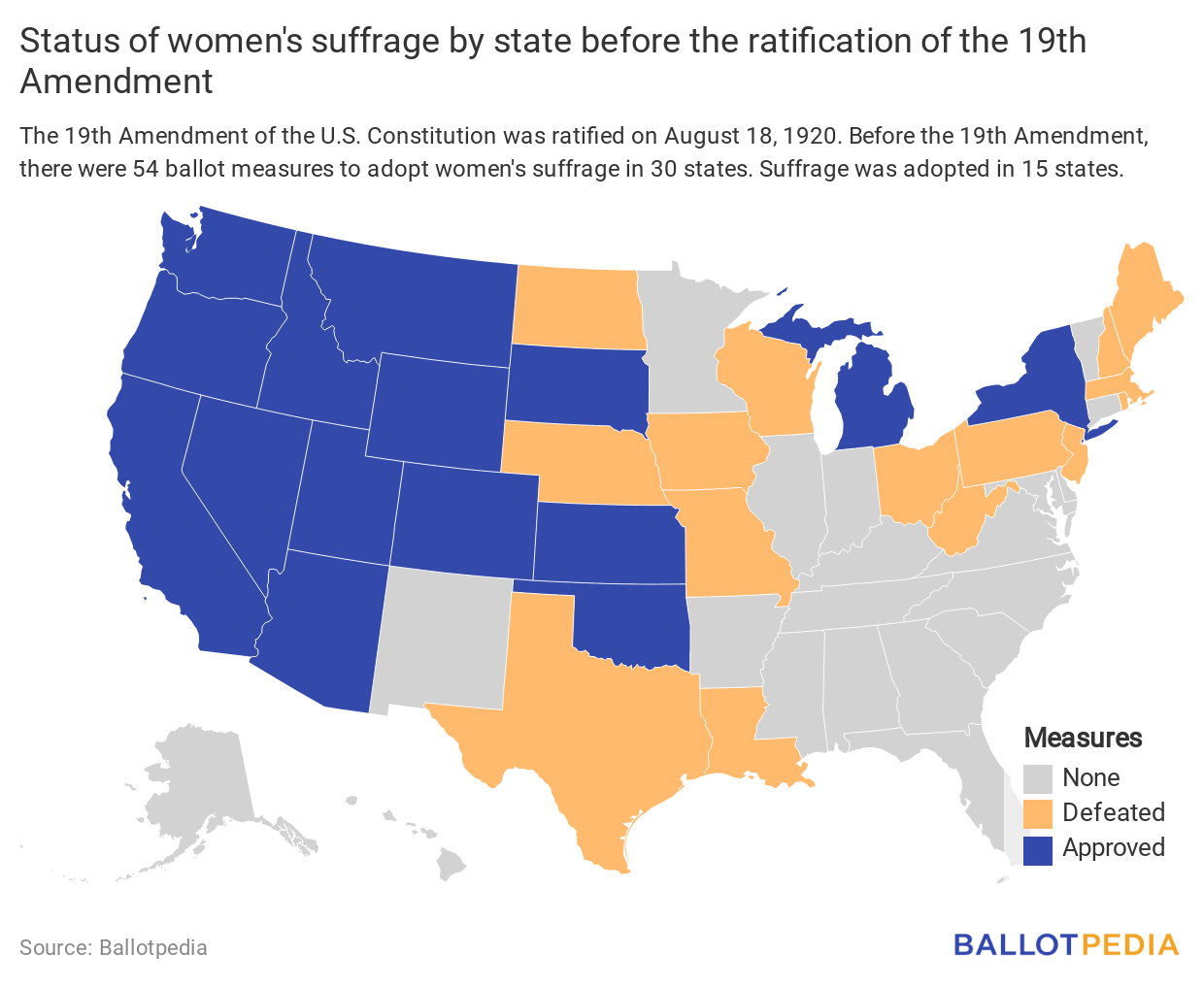The history of state ballot measures on women's suffrage
Today is the 100th anniversary of the adoption of the 19th Amendment to the U.S. Constitution, which prohibited the government from denying or abridging the right to vote on account of sex.
Three-fourths of the states must ratify an amendment after it has passed both houses of Congress to amend the Constitution. Tennessee was the 36th state—of 48 at the time—to ratify the 19th Amendment on August 18, 1920.
Last week I highlighted the history of the 19th Amendment. Today, we turn our attention to the state ballot measures that came before the adoption of the 19th Amendment.
Between 1867 and 1920, 54 measures to give women the right to vote were on the ballot in 30 states. Fifteen states approved them, giving the women in those states the right to vote. Since women could not vote until after the measures were approved, male voters decided the outcome.

Background
Until 1869, the American Equal Rights Association (AERA) was the leading suffragist organization in the United States. AERA dissolved due to disagreements over strategies and the 15th Amendment, which addressed race, but not gender, and the right to vote. Two organizations formed after the AERA dissolved: the American Woman Suffrage Association (AWSA), which aimed to win suffrage on a state-by-state basis, and the National Woman Suffrage Association, which campaigned for a constitutional amendment. The two groups reconsolidated in 1890, with the National American Woman Suffrage Association (NAWSA) focused on both state referendums and a federal amendment.
Suffragists Carrie Chapman Catt and Nettie Rogers Shuler wrote in their book Woman Suffrage and Politics (1923) that state ballot measures "spun the main thread of suffrage activity" in the movement's earlier years and were seen as stepping stones to national suffrage. "I don't know the exact number of States we shall have to have," said Susan B. Anthony, "but I do know that there will come a day when that number will automatically and resistlessly act on the Congress of the United States to compel the submission of a federal suffrage amendment."
Milestones
Here is a timeline of milestones regarding state ballot measures on women’s suffrage from 1867 to 1920:
-
1867: Kansas was the first state to vote on a state constitutional amendment for women’s suffrage. Voters rejected it, 69% to 31%.
-
1889: Wyoming voters approved their first state constitution, and one of the provisions provided for women’s suffrage. Wyoming was the first state to give women the right to vote.
-
1893: Colorado was the first state to pass a standalone constitutional amendment on women’s suffrage. The male electorate approved the amendment, 55% to 45%.
-
1896 to 1910: Statewide ballot measures granting women the right to vote were defeated 10 times in six different states
-
1910 to 1914: Six states—Washington (1910), California (1911), Arizona (1912), Oregon (1912), Montana (1914), and Nevada (1914)—passed constitutional amendments granting women’s suffrage.
-
1917: Montana voters elected the first woman to Congress. Jeannette Rankin was president of the Montana Women's Suffrage Association and an organizer for the ballot measure campaigns in Washington and Montana.
More interesting facts
Our article on women’s suffrage ballot measures lists all these measures, including election results and other fascinating statistics. Here are five more facts about state activity on women’s suffrage:
-
Ten of the 11 states west of Texas approved women’s suffrage measures. New Mexico never voted on a women’s suffrage ballot measure.
-
Eleven states east of the Mississippi River voted on women’s suffrage ballot measures, and two approved them. New York passed an amendment in 1917, and Michigan passed one in 1918.
-
Six states considered eight ballot measures to grant partial suffrage to women before the ratification of the 19th Amendment. These ballot measures addressed voting in school affairs and elections, local elections, and presidential elections. Voters approved two of these measures—both in Minnesota—and rejected the other six.
-
Six states—Arizona, Idaho, Montana, Nevada, Utah, and Wyoming—passed women's suffrage measures on their first attempt.
-
Nine of the 15 states that eventually approved women’s suffrage measures voted on the issue more than once before passage. Two states—Oregon and South Dakota—passed women's suffrage measures on their sixth attempt.
|